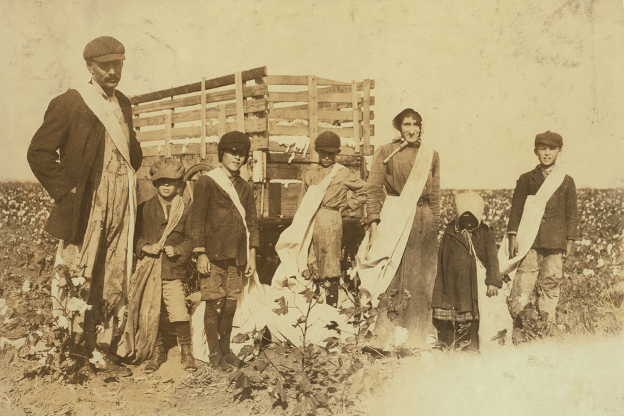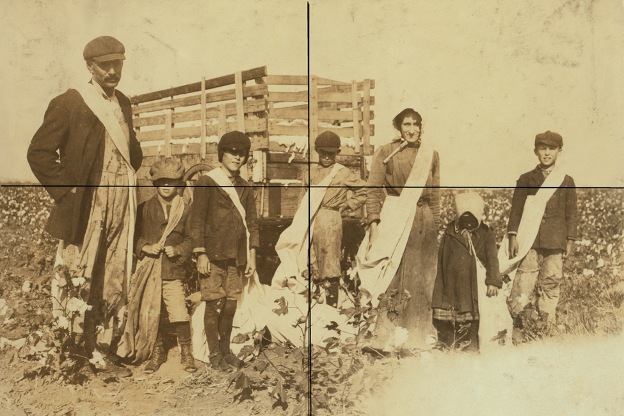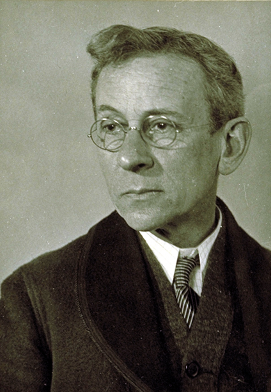
Child Labor in Oklahoma: The Photographs of Lewis Hine, 1916–1917
Activities
Photo Analysis

Family of L.H. Kirkpatrick, Route 1, Lawton, Oklahoma. Children go to Mineral Wells School #39. Father, mother and five children (5, 6, 10, 11 and 12 years old) pick cotton. "We pick a bale in four days." Dovey, 5 years old, picks 15 pounds a day (average) Mother said: "She jess works fer pleasure." Ertle, 6 years, picks 20 pounds a day (average) Vonnnie, 10 years, picks 50 pounds a day (average) Edward, 11 years, picks 75 pounds a day (average) Otis, 12 years, picks 75 pounds a day (average) Expect to be out of school for two weeks more picking. Father is a renter. Works part of farm on shares (gives 1/4 of cotton for rent) and part of farm he pays cash rent. Location: Comanche County, Oklahoma.
Show this photo on the projector or divide students into small groups and give each a copy of the photo. Have students study the photo and write down anything that stands out to them. Next, have students discuss what they think is the importance of the photo.
Discussion questions:
- Why did the photographer feel this moment was important to remember?
- What is the photographer hoping this photo will accomplish?
- How is this photo different from the photos we take today? Are there similarities?
Next, display the same photo but divided into four quadrants. Focusing on one piece at a time, have students describe what they see and the small details they might have missed earlier. After each quadrant has been looked at individually, show the entire photograph again and ask students what they now see.

Discussion questions:
- After analyzing the photo in pieces, what do you see differently about the photo?
- What details did you miss the first time? What do you think those details mean?
- Now that you have studied the photo in great detail, what does it tell you about child labor in the early 1900s?
Creative Writing Activity: Diary or Journal Entry
Have students choose a Hine photograph from Oklahoma. After studying the photo, have students do a free write about their observations and feelings about the piece. Provide the following prompts:
- How old does the child/children look?
- What is their physical condition? (Do they look healthy, properly clothed, happy?)
- Does this job look safe?
- What kind of home or family do you think the child/children live in or come from?
- Do you think this child/children have time to go to school?
Next, have students create a diary or journal entry for a child in the photograph. Have them describe what the child is like (their name, how old they are, what they are doing) and their workday as this new character. Be sure to have students write this entry in first person and to include their reasons for working and how they feel about their job.

The Mill: Some boys and girls were so small they had to climb up on to the spinning frame to mend broken threads and to put back the empty bobbins. Bibb Mill No. 1. Macon, Georgia.
Social Reform Discussion
In the form of a class discussion, have students share what kinds of work or jobs they do either around their house or at school.
Discussion questions:
- Do you have chores at home or responsibilities at school?
- Are any of these jobs dangerous?
Next, have students participate in a conversation about why children are no longer allowed to work at such young ages or for long hours in places that are not safe. Now, have them consider another set of questions about responsibility.
Discussion questions:
- Should the government regulate child labor? What about jobs that adults do?
- Who should be in charge of these rules?
- What social injustices do you see today, perhaps when you watch the news or read books or magazines?
- How can we help children laborers in other countries who are not protected by these laws?
The Child Labor Coalition http://stopchildlabor.org/
Interactive Child Labor World Map http://stopchildlabor.wpengine.com/?page_id=139

A child laboring in a United States tobacco field (image courtesy of Stop Child Labor Coalition).
Primary Source Quote
Read the primary source quote and answer the questions below.
If I could tell the story in words, I wouldn't need to lug around a camera. —Lewis Hine
- What does Hine mean by this?
- Can photographs be more powerful than words sometimes? Why?
- Why do you think it is important that we remember the child laborers that Hine photographed?

Johnnie, Carrie and Jim Davenport picking cotton for Mr. J. P. Daws, Route 1, Shawnee. Johnnie picks 75 pounds, Carrie 100 pounds and Jim 150 to 200 pounds a day. Get $1.00 a hundred pounds. No School yet. Mother is a renter; moves about a great deal.] Location: Pottawotamie County, Oklahoma.
Write Lewis Hine a Thank You Letter
Lewis Hine died in 1940 at the age of sixty-six, only two years after the Fair Labor Standards Act was passed. Impoverished and homeless when he died, many people had long forgotten about him and his photographs. He never knew that decades later his life's work would become synonymous with social reform documentary photography.
Have students think about the importance of standing up for others and the contribution that Lewis Hine's photos made in the effort to protect children from dangerous working conditions and allowing them to get an education. Then, have students write a thank you letter to Hine. Be sure they include why his work is important and how his photos affect children in Oklahoma and around the country today.

Lewis Hine (Image courtesy of the International Photography Hall of Fame).

